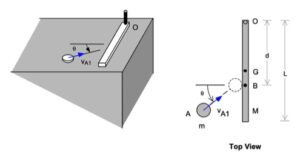| Problem statement Solution video |
DISCUSSION THREAD

Any questions?? Please ask/answer questions regarding this homework problem through the "Leave a Comment" link above.
| Problem statement Solution video |
DISCUSSION THREAD

Any questions?? Please ask/answer questions regarding this homework problem through the "Leave a Comment" link above.
Comments are closed.
For this question, I started with the angular impulse momentum equation. Since the bar isn't rotating initially, it doesn't contribute to H1. I believe the puck contributes in H1, and we should use the equation r x mv and split va1 into i and j components. On the other hand, for H2, the bar and puck contribute after the collision.
After the strike, would the moment of inertia be the I of the bar plus a contribution from the particle?
I think the particle would become part of the bar after collision and therefore only contribute its mass to the moment of inertia expression.
My recommendation is to treat the bar and the particle separately in your analysis, and at the end add together. That is, the angular momentum of the bar is I_O*omega, and the angular momentum of the particle is m*(r_A/O x v_A), where I_O is the mass moment of inertia of just the bar.
Does this make sense?
Don't forget you can use kinematics to find the unknown velocity 2.
I found Example 5.C.5 to be helpful in figuring out how to solve this problem. The approach (using angular impulse-momentum) is very similar.
Would the Parallel Axis Theorem be necessary for this problem?
Since the bar is not rotating around its CG, you will need to use the parallel axis theorem
The need for using the PAT depends on the choice that you make for the reference point.
* If you use the center of mass of the rigid body as the reference point, then you use the mass moment of inertia of the body about its CM. Since mass moment of inertia values are typically published for the CM, then you would not need to use the PAT.
* However, if you choose a fixed point as your reference point, and that fixed point is not the CM, then you would need to use the PAT for finding the mass moment of inertia.
Is it good to assume that there are no external forces acting on the n-axis of the collision, therefore impulse would be zero? Or would we have to derive omega by other means
This depends on what you choose for your system, and on which point that you choose for your reference point. It is recommended that you put the particle A and the bar together in the system. In that case, along with using the fixed point as your reference point, there will not be an angular impulse about O.
In any case, it is not really an assumption, but more of a consequence of choices.
Are we able to say the initial r_(A/O) is equal to L?
"Puck A, with a mass of m, strikes the bar at point B (located at a distance of d from the pin at O) with a speed of vA1," I made the same mistake initially. I believe it is V1 striking at distance of d not L, and you do right before and right after with the same distance d for the puck as a particle.
I found it helpful to separate the bar and the puck into two separate parallel axis theorem equations. Treating the two separately is easier than treating it as one system overall.
Is using the coefficient of restitution here applicable? The problem statement mentions that the puck and the bar remain stuck, so e = 0, or is there something I'm missing?
True, e = 0.
But what is more significant is that A sticks to the bar, meaning that A has the same velocity as the corresponding point on the bar.
You know you need the angular momentum equation because the linear momentum is not conserved due to the reaction force on the spike, and you do not want to add in another variable that you're not trying to find.
The question is simple I believe -- what caught me for a while was recognizing what "sticking" implied for the angular velocities of the final system regardless of their distance from point O. With this information and a big system (where there are no external torques), you can solve for the angular velocity of the bar.
Angular impulse momentum is needed since linear momentum is not conserved. From this, you can solve for the angular velocity. Parallel axis theorem will be necessary to use in this problem if you don't choose the center of mass as your fixed point.
For this problem is there a way for us to interpret how to tell if it sticks intuitively? I believe we have to solve anyways regardless.
Also note, To solve this question some general advice. You have to acknowledge that only a portion of the initial velocity of the puck constitutes to the rotation of the bar...as in one must consider that only the normal contribution causes rotation. If you utilize angular momentum conservation you can solve for the angular velocity at state two knowing this information. Keep in mind, I will be a combination of the Inertia of the bar and parallel axis theorem. Good luck and hope this helps as always.
This problem is very similar to example 5.C.5. The main difference is the fact that the particle is striking the bar at an angle, so when accounting for its angular momentum, you will have to use a vector that is described by cos and sin theta.
Angular momentum about O is conserved